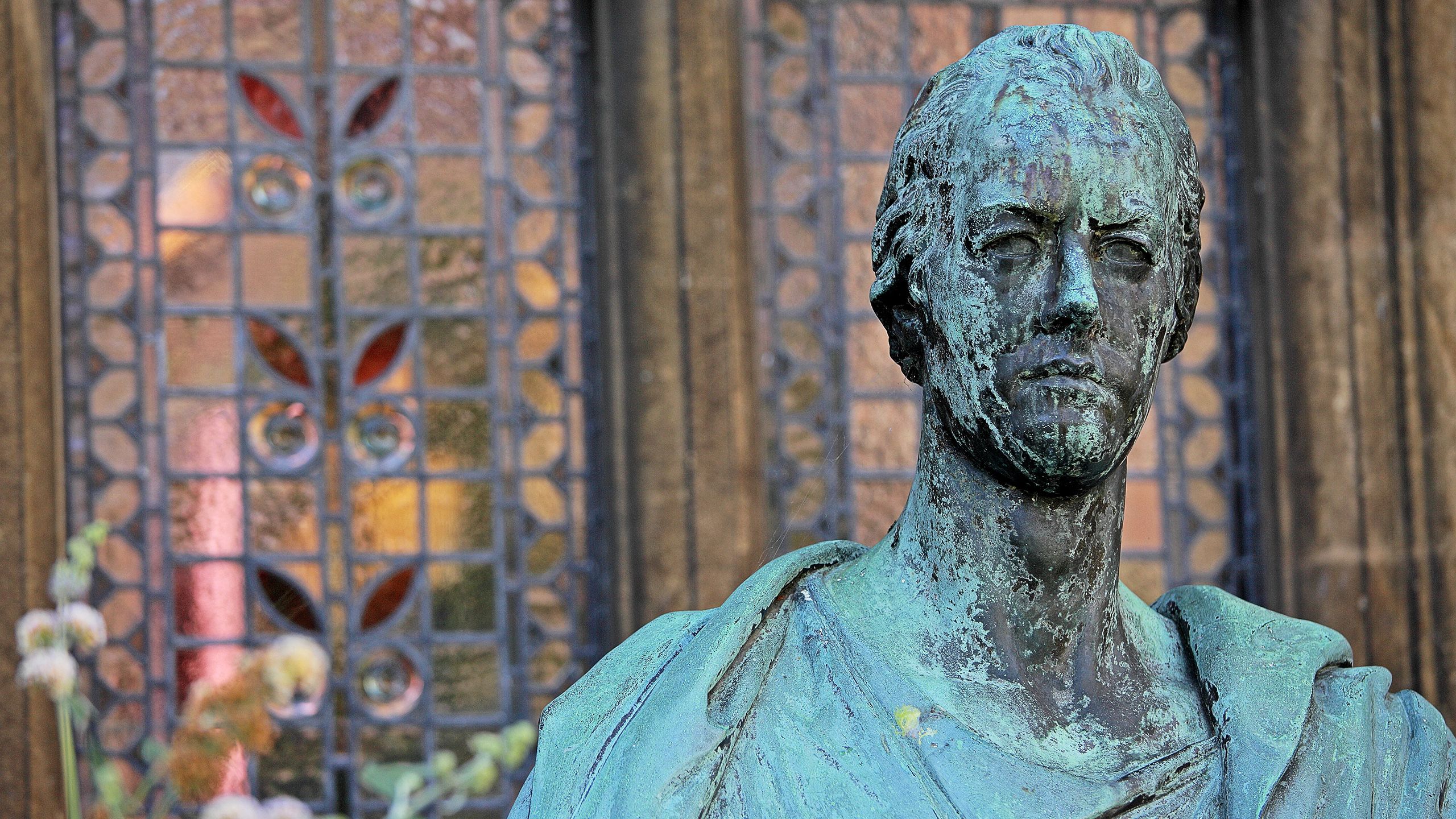Talking about a revolution
25 years of BT and Cambridge

BT is a global telecommunications company with 100,000+ employees worldwide, serving customers in more than 70 countries.
Cambridge is one of BT's four strategic university partners worldwide.
Cambridge and BT have been working together for more than 25 years developing new technologies, exploring human behaviour and considering how those two things come together to shape our world.
Research collaborations span engineering, computing, physics, materials science, social anthropology, and business and management.
BT is a member of Pembroke's Corporate Partnership Programme.
Back in 2000, fewer than half of UK households had a mobile phone. If you wanted to get in touch with someone, you would try calling them on their landline and keep your fingers crossed that they were at home.
Since then, how we communicate, how we do business and what we do for fun have changed beyond all recognition. For the past 20 years, BT and Cambridge have been working together to understand both the technological possibilities of our new digital world and also the effect those technologies could have on us.
“We’re a company that does research. Our world-leading teams generate patents, publish papers and attend conferences,” explains BT’s MD of Applied Research and Pembroke College William Pitt Fellow, Professor Tim Whitley.
“Collaboration with academia is a crucial part of that process for us. Working with experts from other organisations challenges our thinking and brings our teams into contact with people from many different disciplines, such as social sciences and business schools, often with different perspectives.”
“Our relationship with Cambridge has a strong track record of delivering value to our business through technical innovation and strategic insight for more than 20 years.”
Designing products for everyone

One of BT's most longstanding collaborations – with the University’s Engineering Design Centre (EDC) and Professor John Clarkson – was started in the early 2000s by Jeff Patmore, then head of BT’s strategic university relationships.
According to government figures, just under a quarter of people in the UK have some kind of disability, increasing to almost half of those of pensionable age.
With funding from BT, Clarkson and his team, working with Roger Coleman, Professor of Inclusive Design at the Royal College of Art, developed an inclusive design training course which they delivered to designers and product managers across BT. The outcomes were impressive and included the 2008 launch of two bestselling BT products which incorporated all the principles of inclusive design: the Freestyle 750 series phone and a more user-friendly Home Hub 2.0.
Since then, the University's toolkit for inclusive design has been adopted internationally as the 'gold standard' and its principles have been incorporated in the UK's national curriculum for Design and Technology. For Clarkson, "The thinking and all the early development of the toolkit was funded by BT. Its support was instrumental in making all of that happen. We simply couldn't have done it any other way."
But that's not the end of the story. The approach, first developed in the early 2000s, has stood the test of time. BT is currently funding a PhD student, supervised by Clarkson, who is helping to design internal software packages to make them user-friendly and fully inclusive.
Another type of academic engagement pioneered by Patmore and Clarkson was rapid research into how new communications technologies were affecting human behaviour.
This was prompted, explains Patmore, "by increasing concern in the media about the impact of the internet, particularly on children. These were big questions BT decided it needed to answer. We needed to think about the consequences of making the internet accessible to everyone."
"We needed to think about the consequences of making the internet accessible to everyone."
Jeff Patmore, former Head of Strategic University Research & Collaboration at BT
The result was an ambitious study of internet usage and its impact on families and their wellbeing in the UK, US, China and Australia, Culture Change in Communication.
Changing the culture at BT

Organisational culture has been another area of mutual interest for Cambridge and BT over a long period of time, led by Dr Philip Stiles at the Cambridge Judge Business School.
"The stakes here are high," explains Stiles. "BT is what we call a high reliability organisation. It has to achieve 99.99999% reliability in its core telephony network, and to run an organisation like that, you need precision and consistency." But BT is also undergoing digital transformation, moving away from the traditional switched network to a voice over internet protocol network (VOIP) approach.
"The introduction of this technology has required changes in infrastructure, skills, ways of working and culture generally, as BT combined the needs for consistency and a flawless service with innovation and change. Of particular interest was the use of self-managing teams to manage the transition."
"... engineers worked in leaderless teams adopting cross-functional and highly flexible ways of working and showed how continuity and innovation can be combined."
Dr Philip Stiles, Director of the Centre for Human Resource Management, Cambridge Judge Business School
"One of the outcomes," says Stiles, "was that it cemented the idea of these self-managing teams. Rather than a traditional hierarchical leadership approach to change, engineers worked in leaderless teams adopting cross-functional and highly flexible ways of working and showed how continuity and innovation can be combined.”
AI for more resilient networks

BT's commitment to understanding the 'people' side of technology is also reflected in Stiles' involvement in a major technology project, Next Generation Converged Digital Infrastructure (NG-CDI) alongside colleagues from Cambridge's Institute for Manufacturing and teams from the Universities of Lancaster, Bristol and Surrey.
NG-CDI is a Prosperity Partnership project jointly funded by BT and ESPRC to secure the UK's telecommunications networks for the future.
Professor Ajith Parlikad from the IfM explains: "As 5G comes on stream and things like self-driving vehicles, virtual reality and the Internet of Things become a normal part of our everyday lives, we are going to see an unprecedented demand placed on our communications networks. Current networks will simply not be able to cope."
"We are going to see an unprecedented demand placed on our communications networks. Current networks will simply not be able to cope."
Professor Ajith Parlikad, Institute for Manufacturing
The multi-university, multidisciplinary team aims to develop a smart network that can react to and even predict changes in networking demand and reconfigure the infrastructure accordingly with minimal human intervention.
But it's not just about the technology. "For BT," explains Stiles, "this programme represents a huge organisational as well as technical challenge, with implications for how the business is structured, and how current ways of working will need to change.
"If the network is going to be run by AI, how do you ensure that the algorithms are the right ones and do exactly what you want? What happens if something goes wrong? At the moment, if part of a system breaks down, BT has got clever engineers who can work out where the problem is. With AI, it's not always clear how to identify the problem and fix it."
"That's where we come in. Our part of the project is to look at the risks involved, and the kinds of governance BT will need to put in place to mitigate those risks."
A quantum leap

Making networks 'unhackable' is another active area of research collaboration, both with Professor Richard Penty in the Department of Engineering and with Mike Payne, Professor of Computational Physics at the Cavendish Laboratory and BT Corporate Fellow at Pembroke.
A huge amount of work is going on at Cambridge – and elsewhere – in quantum key distribution (QKD). While Payne is sceptical of much of the hype surrounding quantum more broadly, he thinks there is "one clear area of application in creating secure communications networks".
Penty takes up the story: "With today's technology, it would take an unfeasible amount of computing power to crack conventional encryption algorithms and work out their keys. But at some point, someone will invent a quantum computer that is big enough to do it.
"QKD essentially solves the problem in advance. By making use of the fact that photons are individual particles of light and therefore have quantum mechanical properties, you can devise a protocol for sending a key securely from one place to another. If you wanted to, you could also update the key every millisecond. However, one of the technical challenges is that it's very difficult to send both the key and the data you are encrypting over the same fibre."
And this is where another feature of the Cambridge-BT partnership comes into play – geographical proximity between the University and BT Research in Martlesham, Suffolk.
This has resulted in what Carol Fletcher, head of BT’s Strategic Partnership Programme with Universities and Schools, describes as "a genuine world-first: together we designed and implemented what at the time was the longest quantum secured network running from our campus in Suffolk to Cambridge."
"... together we designed and implemented what at the time was the longest quantum secured network..."
Carol Fletcher, head of BT’s Strategic Partnership Programme
Combatting conspiracy theories

During the pandemic, BT saw a sudden rise in the number of attacks on its 5G masts and threats made to its staff. Fuelling these activities was a conspiracy theory, widely shared on social media, that 5G was responsible for spreading the coronavirus.
Naturally, BT was interested in finding a way to monitor the spread of disinformation with a view to identifying potential threats. In 2021, as part of the Cambridge Grand Challenges programme, Andrea Kocsis, a PhD student in the Department of Archaeology, spent six months at BT pursuing her interest "in misinformation and fake news".
She joined BT's Security research team to develop an automated way of detecting the spread of misinformation on Twitter by using machine learning to differentiate between those with malicious intent versus news reporting and general chatter around the topic.
Kocsis explains that the next stage of the project is "to integrate the results into a software which is able to catch those tweets about 5G which can trigger direct aggression."
"This project is a great example", says Fletcher, "of how we can work the University in lots of different ways. Being able to bring in some expertise from a slightly different domain to look at this problem has been really helpful."
For Director of Cambridge Grand Challenges, Dr Konstantina Stamati, the benefit is mutual. "Companies that host a PhD student benefit hugely from their knowledge and expertise. But it's also fantastic for the student who gets to spend time in an organisation, looking to solve a particular problem while gaining valuable skills and experience."
A college home

In 2003, BT joined the pioneering Pembroke College Partnership programme. Today, the relationship with Pembroke remains strong and is one of the things that Fletcher values about Cambridge. "It helps us develop all the different types of engagement we have with the University, whether it's the high-profile BT-Pembroke Annual Lecture, hosting brilliant Pembroke students as interns, supporting MBA student projects at the Business School, or working together on STEM outreach."
"Pembroke also helps us find the people across the University who can test us and challenge us, to help our researchers with what they're doing and to help us understand where our next big challenge or our next big success is going to come from."
The last word goes to BT Corporate Fellow, Mike Payne: "Our partnership with BT is founded on honesty, trust and integrity. To maintain this relationship over such a long period of time with so many different people involved is really quite remarkable and says a lot about the company."
Published 14 October 2022
Photography
Digital globe. Getty Images. Credit: Piranka
Old friends catching up. Getty Images. Credit: SolStock
Woman working at a BT contact centre. Credit: BT
Rendering of binary code pattern. Getty Images. Credit: MR.Cole_Photographer
Quantum computing concept. Getty Images. Credit: Vchal
Communications tower. Getty Images. Credit: Lucas Ninno
Statue of William Pitt, Pembroke College. Credit: University of Cambridge
The text in this work is licensed under a Creative Commons Attribution 4.0 International License

